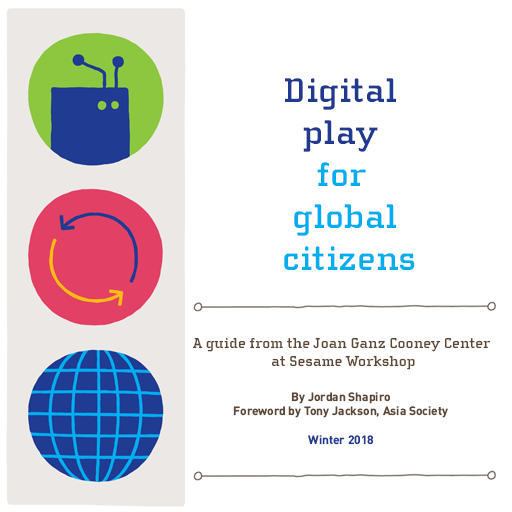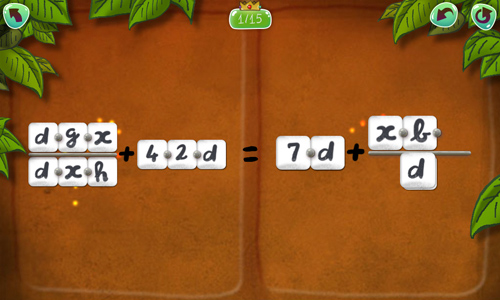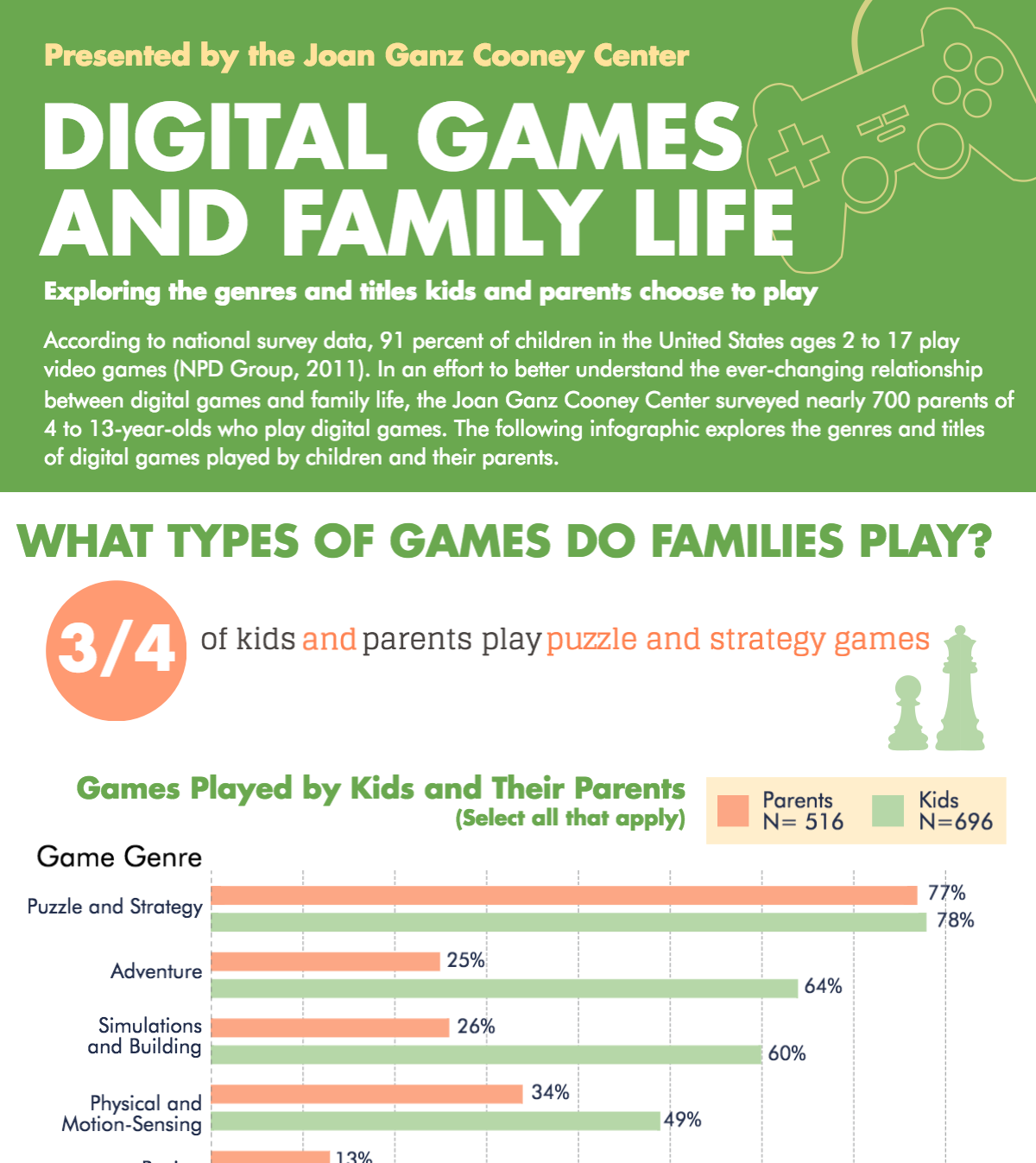The Joan Ganz Cooney Center’s newest Digital Games and Family Life infographic looks at the game genres and titles that kids and their families play. Not surprisingly, there seems to be a generational gap. There is also a curious gender distinction.
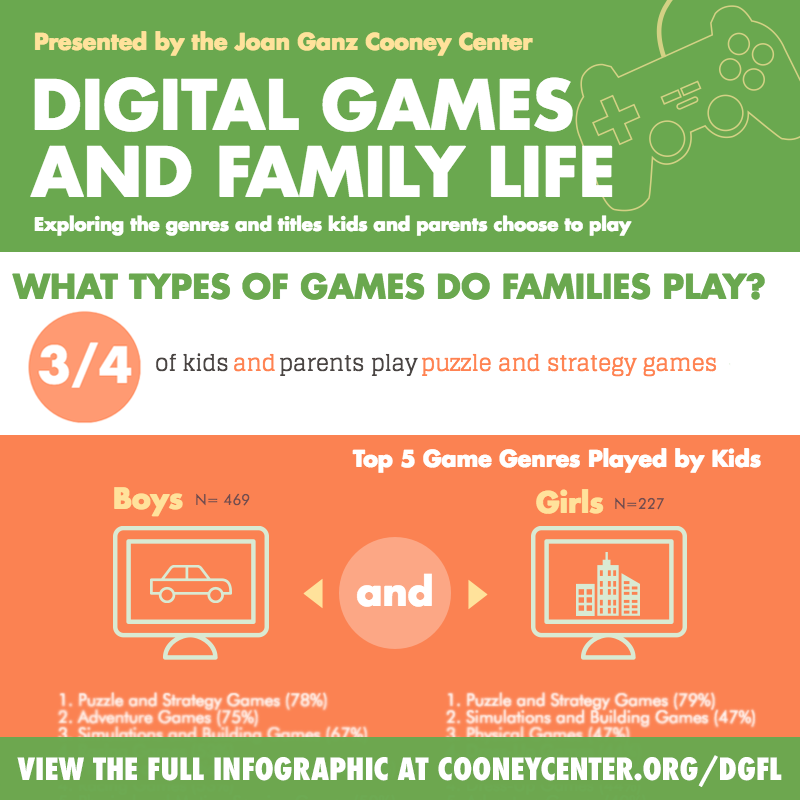
When it comes to age, puzzle/strategy games, first person shooters and role-playing games have universal appeal. They seem to be equally popular among parents and their children. I’d like to imagine that it is because families are playing Halo together. That’s the way it works in my house right now. We all visited Microsoft’s Redmond campus last month and after seeing so many Master Chief statues, our family bonding became a nostalgic tribute to a memorable vacation. But even when we are not all on the sofa, gamepads in hand, we still find ways to play together. For example, we are deeply engrossed in the gorgeous puzzler Dots & Co. We play it on our respective devices, competing to see who advances more quickly (I’m winning; level 173). Some types of games cross generational boundaries.
My boys (ages 9 and 11) play a lot more without me than they do with me. Often, they are playing the other categories on this infographic—racing, virtual worlds, fighting, adventure, and especially simulation building games like Minecraft. Those genres seem to appeal disproportionately to younger players. All except that one outlier: brain training/trivia games. Do these games attract adults because there is still a video game stigma? Do adults like to pretend games are work? Do brain trainers feel like a New Year’s resolution, somehow less superficial? Like tech-enabled personal development?
I honestly cannot relate to this phenomenon. Brain trainers puzzle me. I have read so much that debunks their claims; any reputable neuroscientist will tell you there is no documentable proof that these games have real benefits. So I don’t play them (why would I when there are so many titles that are so much more fun).
Still, I acknowledge that all games are doing some sort of “training.” It’s safe to say that whenever anyone is gaming, they are actually learning. At the most basic level, players learn how to navigate their way through the system of the game. They learn when to jump and when to shoot. They master the motions the game requires.
Embedded beneath the simple lessons about how to play the game-at-hand are more complex social, emotional, and cognitive lessons about how to play the game-of-life. For instance, I have talked to lots of successful start-up entrepreneurs who credit a childhood immersed in 1980s Nintendo SNES games for helping them develop what many education writers call character skills. “I learned resilience,” one told me, “Kid Icarus was super hard. But day after day of trying again and again taught me that if I stick to something, eventually I could figure it out. I think Kid Icarus gave me a sense of accomplishment and a healthy relationship to perseverance.” That’s a secret that every gamer knows all to well: you get better at winning by losing…at lot. Games encourage us to see failure as iteration.
Gaming can also influence the way kids will approach their finances when they become adults. For example, hundreds of hours with a simple resource management game, such as Plants vs. Zombies, shape children’s cognitive habits. All that gaming teaches them lessons about assets, liabilities and prioritization. I don’t know exactly which kinds of bonds, mutual funds or savings accounts pea-shooters, puff-shrooms and cabbage-putts correspond to, but I’m fairly certain that my kids learned something about fortifying their position through diversification. Each time they chose plants for their inventory, trial and error taught them how day-to-day choices sway one’s ability to succeed within a complex system. For the record: this is why I hate it when games encourage in-app power-up purchases—the lesson is that instant gratification through consumption, rather than perseverance and planning, leads to success.

Thinking about games in this way should make us concerned about gender distinctions in gaming choices. According to our latest infographic, girls and boys are playing different kinds of games. Of course, that’s okay in itself. All you have to do is spend a few minutes on the App Store to see that pink and blue signifiers have occupied digital retail just as much as they have the racks at Target. Girls can have their cupcakes, dress-up, and Frozen. Boys can have their trucks, guns, and Iron-Man. But ultimately, I wonder whether or not the lessons that are embedded in the games’ mechanics are also divided by gender.
When girls are playing “dress-up” video games—the number four most popular category according to this infographic—are they managing resources or just making things look pretty? I hope it’s not all about aesthetics. We know, without a doubt, that we need to teach lessons in resource management, sustainability, and prudence to all of our children, regardless of their anatomy.
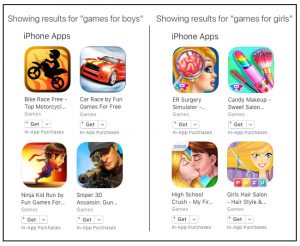
Of course, we don’t have enough information here to jump to any conclusions. We desperately need folks to look, in much more detail, at the specific games our children are playing.
Calling all sociologists, cultural studies departments, critical theorists: please do more work on the qualitative distinctions among game titles, the agendas they inadvertently promote, and people who play them. We need to analyze each game’s rhetoric. We need to really understand the games’ rules, the objectives, the way each system operates and the habits of mind that particular kinds of gameplay encourage.
Parents: it’s clear that you aren’t playing most of the game categories. That’s a problem. You don’t really know to what your children are being exposed. Please drop the brain trainers and diversify your gaming choices. Most importantly, start gaming with your kids.
